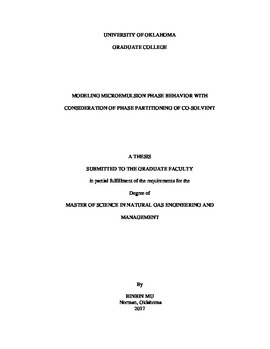| dc.contributor.advisor | Jamili, Ahmad | |
| dc.contributor.author | Mu, Binbin | |
| dc.date.accessioned | 2017-05-03T14:57:00Z | |
| dc.date.available | 2017-05-03T14:57:00Z | |
| dc.date.issued | 2017-05-12 | |
| dc.identifier.uri | https://hdl.handle.net/11244/50448 | |
| dc.description.abstract | Co-solvents are widely used to improve chemical flooding formulations design, but partitioning of co-solvent within phases has great impacts on microemulsion phase behavior. Microemulsion phase behavior plays a key role in surfactant flooding processes. Therefore, it is critical to accurately model microemulsion phase behavior with the consideration of co-solvent phase partitioning in a compositional chemical flooding simulation.
The physics based Hydrophilic Lipophilic Difference and Net Average Curvature (HLD-NAC) equation of state (EOS) coupled with the thermodynamic-based co-solvent partitioning model was developed in this work to model microemulsion phase behavior for the systems contained co-solvents.
Five microemulsion systems were used to examine the developed approach. Solubilization ratios under salinity scan of these systems were reproduced. The matching length parameters were underestimated for each system by assuming all co-solvents were completely adsorbed at the phase interface instead of using the co-solvent partitioning model. However, length parameters were more physically representing the actual surfactant tail lengths when determined by the developed model. The results proved that the improved HLD-NAC model which accounted the co-solvent partitioning model can accurately simulate phase behavior of surfactant/ co-solvent/oil/ brine systems.
The improved HLD-NAC model then was used to determine the length parameter for the system consisted of brine, n-decane, 1.5% of Witco TRS 10-410 and 1.5% of isobutyl alcohol (IBA). After determination of length parameter, catastrophic phase inversion theory and Khorsandi and Johns’s flash algorithm coupled with co-solvent partitioning model were employed to reproduce the binodal curves based on experimental data. And then, the accuracy of the model binodal curves was examined. The model binodal curves created by catastrophic phase inversion theory were not able to reproduce the experimental binodal curves for the system to acceptable extent. Significant errors may occur when estimating the number of phases and the concentrations of compositions in microemulsion phase with the plotted ternary diagrams. However, the Khorsandi and Johns’ flash algorithm with consideration of co-solvent phase partitioning can accurately simulate phase behavior for all Winsor type microemulsions. The results proved that the new algorithm can make better model binodal curves in the ternary diagrams of the surfactant/co-solvent/crude oil/brine systems. A flow chart for the new algorithm as well as the results of tuning parameters were presented and demonstrated in this work. | en_US |
| dc.language | en_US | en_US |
| dc.subject | Engineering, Petroleum. | en_US |
| dc.title | Modeling Microemulsion Phase Behavior With Consideration of Phase Partitioning of Co-Solvent | en_US |
| dc.contributor.committeeMember | Shiau, Bor-Jier (Ben) | |
| dc.contributor.committeeMember | Wu, Xingru | |
| dc.date.manuscript | 2017-04-27 | |
| dc.thesis.degree | Master of Science in Natural Gas Engineering and Management | en_US |
| ou.group | Mewbourne College of Earth and Energy::Mewbourne School of Petroleum and Geological Engineering | en_US |
